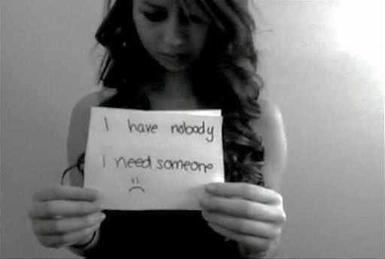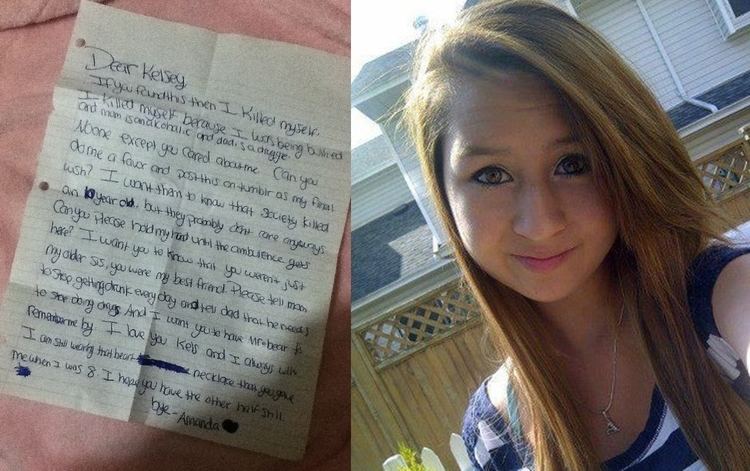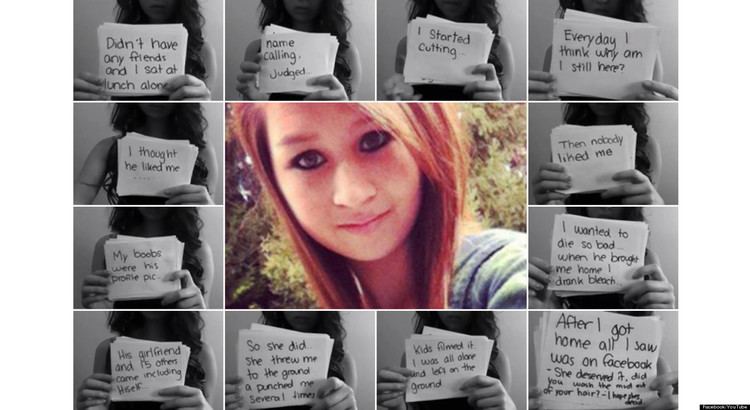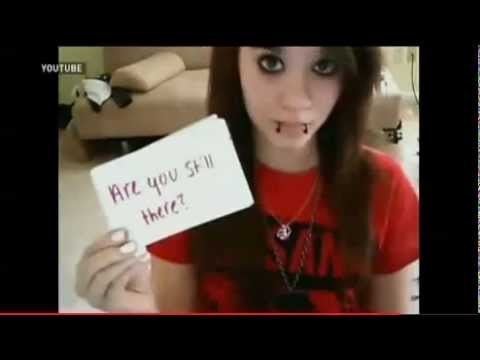Cause Suicide Coroner Barb McLintock | Suspect(s) Aydin Coban Name Suicide Amanda | |
 | ||
Inquest British Columbia Coroners Service Charges Indecent assault and child pornography (Netherlands) Similar Suicide of Jadin Bell, Suicide of Ryan Halligan, Kenneth Weishuhn | ||
On October 10, 2012, Amanda Michelle Todd (November 27, 1996 – October 10, 2012), a 15-year-old Canadian girl, committed suicide at her home in Port Coquitlam, British Columbia, Canada. Prior to her death, Todd had posted a video on YouTube in which she used a series of flash cards to tell her experience of being blackmailed into exposing her breasts via webcam, and of being bullied and physically assaulted. The video went viral after her death, resulting in international media attention. The video has had more than 12 million views as of February 2017. The Royal Canadian Mounted Police and British Columbia Coroners Service launched investigations into the suicide.
Contents
- Amanda Todd Bullied Teen Commits Suicide
- Background and suicide
- Investigation arrest and conviction
- Reaction
- Mainstream media
- Social media
- Amanda Todd Legacy Society
- Legislative impact
- References

In response to the death, Christy Clark, the Premier of British Columbia, made an online statement of condolence and suggested a national discussion on criminalizing cyberbullying. Also, a motion was introduced in the Canadian House of Commons to propose a study of the scope of bullying in Canada, and for more funding and support for anti-bullying organizations. Todd's mother Carol established the Amanda Todd Trust, receiving donations to support anti-bullying awareness education and programs for young people with mental health problems.

Amanda Todd: Bullied Teen Commits Suicide
Background and suicide

On September 7, 2012, Todd posted a 9-minute YouTube video entitled My Story: Struggling, bullying, suicide and self-harm, which showed her using a series of flashcards to tell of her experiences being bullied. The video post went viral after her death on October 10, 2012, receiving over 1,600,000 views by October 13, 2012, with news websites from around the world linking to it.

During the video, Todd writes that when she was in grade 7 (2009/2010), around the same time she moved in with her father, she used video chat to meet new people over the Internet and she received compliments on her looks. A stranger convinced Todd to bare her breasts on camera (an exploitive phenomenon known as "capping", short for screen capturing), following one year of attempts at having her do so. The individual later blackmailed her with threats of providing the topless photo to her friends unless she gave him a "show"; she also featured briefly, albeit circumstantially, on the faux animated news show Daily Capper on BlogTV in an incident which attracted the vigilante attentions of the group Anonymous after her suicide. An episode of Daily Capper which attempted to take the moral high ground, very different in tone from their usual exploitative material, was released a month after her death.
Todd wrote that during the Christmas 2010 break, police informed her at 4:00 a.m. that the photo was circulating on the Internet. She wrote that she experienced anxiety, depression, and panic disorder due to her experiences of being sexually exploited online and being cyberbullied. Her family moved to a new home, where Todd later stated that she began using drugs and alcohol.
A year later, the individual reappeared, creating a Facebook profile which used the topless photograph as the profile image, and contacting classmates at her new school. Again Todd was teased, eventually changing schools for a second time. She wrote that she began chatting to "an old guy friend" who contacted her. The friend invited Todd to his house, where they had sex while his girlfriend was on holiday. The following week, the boy's girlfriend and a group of about 15 others confronted Todd at school, shouting insults, with the boy's girlfriend punching her; Todd fell to the ground, then lay in a ditch where her father found her. Following the attack, Todd attempted suicide by drinking bleach, but she survived after being rushed to hospital to have her stomach pumped. "It killed me inside and I thought I was gonna actully [sic] die", Todd commented in her video about drinking bleach.
After returning home, Todd discovered abusive messages about her failed suicide attempt posted to Facebook. In March 2012, her family moved to another city to start afresh, but Todd was unable to escape the past. According to her mother, "Every time she moved schools he would go undercover and become a Facebook friend. What the guy did was he went online to the kids who went to (the new school) and said that he was going to be a new student – that he was starting school the following week and that he wanted some friends and could they friend him on Facebook. He eventually gathered people's names and sent Todd's video to her new school", including students, teachers and parents. Six months later, further messages and abuse were still being posted to social networking sites. Todd's mental state worsening, she began to engage in self-mutilation – cutting. Despite taking her prescribed anti-depressants and receiving counseling, she overdosed and was hospitalized for two days.
Todd was taunted by other students at her school for her low grades, a consequence of a language-based learning disability, and for the time she spent in hospital to treat her severe depression. "It didn't really help that after she got out of the hospital recently some kids started calling her 'psycho' and saying she had been in the crazy hospital," her mother said. "She went to the hospital, she had therapy, she had counselling, she was on a good track. On the day she gets out, that happens. I shake my head and I think, 'Are kids really that nasty, do they really not think, what if it was them?'"
On October 10, 2012, at about 6:00 PM (PDT), Todd was found dead at her home. At the time of her death, Todd was a grade 10 student at CABE Secondary in Coquitlam, a school that caters to students who have experienced social and behaviour issues in previous educational settings.
Investigation, arrest and conviction
A preliminary investigation by British Columbia Coroners Service showed that Todd's death was a suicide. The cause of death was reported in some media as hanging, however the exact cause of death has not been released.
Both the Royal Canadian Mounted Police (RCMP) and British Columbia Coroners Service launched an investigation with twenty full-time investigators working on the case. The Coquitlam and Ridge Meadows serious crime teams cooperated in a full investigation, conducting interviews and examining potential factors that may have contributed to Todd's death. Investigators are reviewing content at social media sites and are actively monitoring pages.
The Canadian national organization Cybertip.ca reported having received a tip about Todd nearly one year before her suicide. The anti-child-exploitation group stated that, in November 2011, a concerned citizen reported that images of Todd were in circulation on the Internet. That information was provided to law enforcement as well as child welfare agencies. According to the CBC News program, The Fifth Estate, the RCMP were contacted repeatedly that the juvenile was being sexually extorted by an adult male, and in response the RCMP told the family there was "nothing that could be done" about it. According to the Ontario Provincial Police (OPP), however, the crime of "sextortion" is investigated quite successfully.
Following an investigation by Facebook's security unit, whose report was forwarded by U.S. authorities to the Child Exploitation and Online Protection Centre attached to the British National Crime Agency, and then to Dutch authorities, in January 2014 Dutch police arrested a man in a case involving multiple victims in the Netherlands, U.K., and Canada, having installed spyware on his computers; "chilling" chat logs of extortion, numerous images of child pornography, and 5,800 bookmarked names which served as a database of potential victims and their social networks were found. In April 2014, it was reported that Dutch authorities charged a 35-year-old man with dual Dutch and Turkish citizenship (identified only as "Aydin C." within the Netherlands in accordance with Dutch privacy laws) with indecent assault and child pornography. That same month, the RCMP announced that the man had been charged with extortion, internet luring, criminal harassment and the possession and distribution of child pornography for his alleged activities against Todd and other child victims, both male and female. Todd's mother thanked police, but also said that she believed more than one person was involved. On 28 January 2015, CBC News said that Aydin Coban had written an open letter proclaiming his innocence.
Some child pornography charges were dropped by Dutch authorities in October 2015; Aydin Coban's case went to trial in February 2017, and concluded on March 16, 2017. He faced 72 charges of sexual assault and extortion in the Netherlands involving 39 alleged victims (34 young women and five men in countries as various as Britain, Canada, Norway and the United States, and some of whom had been harassed for years); eventually convicted and sentenced on the Dutch charges of internet fraud and blackmail, he faces five separate Canadian charges related to Todd (herself not one of the 39), and it is anticipated that he would be extradited to Canada no sooner than the middle of 2018 whilst serving his Dutch sentence of 10 years and 8 months. Carol Todd expressed relief at the sentence.
Reaction
Todd's suicide received widespread international media coverage, much of which included a link to Todd's YouTube video and an e-mail address provided by the RCMP appealing for information from the public. Within twenty-four hours of the appeal, over 400 tips were received. The RCMP has stated that its investigation was hindered by the amount of false information in online postings after Todd's death, and scams claiming to raise money for her family.
On October 19, 2012, a series of vigils was held across Canada and internationally to remember Todd and other victims of bullying. A minute of silence was observed by a quarter of a million students in the Toronto District School Board district. On that same date, Todd's mother was a guest of the 2012 We Day event in Vancouver, a week after Todd's death. Bullying had been scheduled as a topic prior to Todd's death and was addressed by speakers Magic Johnson, musician and anti-bullying advocate Demi Lovato and British Columbia Premier Christy Clark.
Initially, Todd's mother was denied entry to an anti-bullying conference for fear that her presence would upset other attendees. The family was invited to attend later events.
On November 18, 2012, 600 people gathered at a final farewell ceremony for Todd at Red Robinson Show Theatre in Coquitlam, near her home. Todd's mother Carol told the gathering that her daughter has left behind "a larger-than-life message that has sparked the world and has made it open its eyes, its ears and its hearts".
Internet hacking and activist group Anonymous alleged that a 32-year-old man was Todd's blackmailer and main tormentor. The group published the Vancouver-area man's name and address on the Internet, resulting in the man's receipt of online threats of vigilante justice. After investigating the tip, police determined that the allegations were unfounded, and said that "false information that is being spread by people who appear to be trying to use Amanda's story to do harm or make a profit" was one of the challenges they faced.
According to an interview with the Vancouver Sun, the publication of his identity on social media sites resulted in over fifty e-mails and "thousands" of Facebook death threats. A member of Anonymous had attempted to dissuade the group from publishing the information, saying that they had the right person, but that the address being published belonged to someone else, not the target. Slate reported that the person who was actually responsible turned out to be 19 rather than 32.
Mainstream media
Michelle Dean of The New Yorker compared Todd's death to the suicide of Tyler Clementi. In an early piece questioning the assumptions of perpetrators of nonconsensual pornography, she quotes Mary Anne Franks:
Women have become, as Franks put it, "unwilling avatars", unable to control their own images online, and then told to put up with it for the sake of "freedom", for the good of the community. And then they are incorrectly told, even if the public is behind them, that they have no remedies in the law. They are shouted down by people with a view of freedom of speech more literal than that held by any judge.
and concludes:
...[But] whatever Amanda Todd might have been thinking, whatever else might be true, she did get one thing out of this: Amanda Todd did manage to, just once, tell her own story. She got to drown out the version of her that strangers had put out on the Web. It's a small comfort. But it was perhaps the only one she had left.
Vancouver Magazine entitled a piece on Todd "The Girl Who Woke Up the World"; in 2012 she was the third-most Googled person, and by 2013 vigils had been held in 38 countries. Her mother herself continues to be the subject of cyber-stalking.
Social media
Following Todd's suicide, more than one million Facebook users "liked" her Facebook memorial page. Mingled among the positive support and comments are continuing attack posts and images from strangers and those claiming to be her former classmates. After one man's derogatory Facebook comments about Todd's death were reported to his employer, the Grafton-Fraser Mr. Big & Tall clothing chain confirmed that he was no longer an employee.
On October 19, 2012, police in New Zealand said they were questioning a 17-year-old boy from Raglan who allegedly posted "inappropriate and disturbing images" on a memorial page for Todd. Police removed the images and shut down the boy's Facebook page.
Todd's suicide engendered the Drink Bleach Internet meme almost immediately thereafter, and four years after her death she was associated with the 2016 movie Suicide Squad (along with Adolf Hitler, Robin Williams and Kurt Cobain in one depiction), a meme which her mother regarded as being unhelpful to those at risk.
Amanda Todd Legacy Society
Todd's mother Carol established the Amanda Todd Trust at the Royal Bank of Canada, receiving donations to support anti-bullying awareness education and programs for young people with mental health problems. (A week after Todd's death, ABC News reported that fraudulent websites had been set up claiming to solicit donations, quoting a statement by Royal Canadian Mounted Police Sgt. Peter Thiessen: "Taking advantage of a family's grief is despicable... We want to get the word out that there is one real account and anyone who is interested can make a donation at any RBC branch to the Amanda Todd Trust Account.") It has since been incorporated as a non-profit colloquially known as Amanda Todd Legacy, with a particular outreach on the mental health issues of adolescents on occasions such as World Mental Health Day on October 10. The Amanda Todd Legacy Award was established in conjunction with the Douglas College Foundation in 2016; three students are awarded $1,000 annually towards their studies. Furthermore Amanda Todd Legacy and Carol Todd have also participated in LGBT advocacy under the aegis of Kids Help Phone, Canada's 24-hour hotline for youth in crisis.
Carol Todd is close friends with Leah Parsons, the mother of Rehtaeh Parsons, and they frequently network on cyberbullying issues. The two women often have speaking engagements about their respective daughters with an emphasis on respect, acceptance, forgiveness and dignity.
Legislative impact
In 2012 a motion was introduced in the Canadian House of Commons by parliamentarian Dany Morin of the New Democratic Party in response to the death of Todd. The motion proposed a study of the scope of bullying in Canada, and for more funding and support for anti-bullying organizations. It was also intended to lay the groundwork for a national strategy to prevent bullying. Morin himself had experienced bullying in school.
In November 2013 Bill C-13 was introduced by Justice Minister Peter MacKay of the Conservative Party; the cyberbullying and revenge porn legislation's warrantless access provisions were criticized by Carol Todd, who remarked that "I don't want to see our children victimized again by losing privacy rights". The definition of cyberbullying itself has been a matter of considerable debate, as have the privacy provisions of the bill (particularly in regards to encryption technologies). It went into effect, however, on March 9, 2015. While it had largely been promoted as protecting minors, it applies to all ages.
